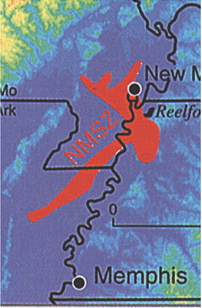Minor tremors could hint at larger quake to come

New Madrid faultline seeing rise in activity
ralphhardin@gmail.com In a report filed in November 2008, the U.S.
Federal Emergency Management Agency warned that a serious earthquake in the New Madrid Seismic Zone could result in “the highest economic losses due to a natural disaster in the United States,” further predicting “widespread and catastrophic” damage across Alabama, Arkansas, Illinois, Indiana, Kentucky, Mississippi, Missouri, and particularly Tennessee, where a 7.7 magnitude quake or greater would cause damage to tens of thousands of structures affecting water distribution, transportation systems, and other vital infrastructure.
So, is “The Big One” we’ve been hearing about for years imminent? Maybe, maybe not. But there has been a spike in underground shifting along the New Madrid Faultline in recent months, most recently an earthquake measuring 2.5 on the Richter Scale in Tiptonville, Tennessee on June 22, as well at a 3.6 quake centered on the Missouri Bootheel in April and a minor 2.1 quake in Kentucky last month.
Of course, any time there’s talk about earthquakes around here, talk turns to more than a century ago when the 1811–12 New Madrid earthquakes rewrote the very geography of this region.
The quakes were an intense intraplate earthquake series beginning with an initial earthquake of magnitude 7.5 to 7.9 on Dec. 16, 1811, followed by a moment magnitude 7.4 aftershock on the same day. They remain the most powerful earthquakes to hit the contiguous United States east of the Rocky Mountains in recorded history. They, as well as the seismic zone of their occurrence, were named for the Mississippi River town of New Madrid, then part of the Louisiana Territory, now within the US state of Missouri.
There are estimates that these stable continental region earthquakes were felt strongly over roughly 50,000 square miles, and moderately across nearly a million square miles. The 1906 San Francisco earthquake, by comparison, was felt moderately over roughly 6,200 square miles.
The three earthquakes and their major aftershocks had an epicenter in northeast Arkansas. It caused only slight damage to man-made structures, mainly because of the sparse population in the epicentral area at the time. The future location of Memphis, Tennessee, experienced “Level 9” shaking, the highest rating on the Mercalli intensity scale. An aftershock six hours later was similar in intensity. A month later, on Jan. 23, 1812, another quake, with an epicenter in the Missouri Bootheel hit.
Eyewitnesses describe the quake as characterized by “ground warping, ejections, fissuring, severe landslides, and caving of stream banks.”
When on Feb. 7, 1812, another series of quakes estimated at between magnitude 7.5 and 8.0 hit near New Madrid, Missouri, the city was virtually destroyed.
In St. Louis, Missouri, many houses were severely damaged, and their chimneys were toppled.
Uplift along a segment of this reverse fault created temporary waterfalls on the Mississippi at Kentucky Bend, created waves that propagated upstream, and caused the formation of Reelfoot Lake by obstructing streams in what is now Lake County, Tennessee.
This is the quake that is credited with creating Dacus Lake in Marion and “causing the Mississippi River to run backwards.”
John Bradbury, a Fellow of the Linnean Society, was on the Mississippi on the night of Dec. 15, 1811, and described the tremors in great detail in his “Travels in the Interior of America in the Years 1809-1811.”
“After supper, we went to sleep as usual: about ten o’clock, and in the night I was awakened by the most tremendous noise, accompanied by an agitation of the boat so violent, that it appeared in danger of upsetting,” Bradbury wrote.
“I could distinctly see the river as if agitated by a storm; and although the noise was inconceivably loud and terrific, I could distinctly hear the crash of falling trees, and the screaming of the wild fowl on the river, but found that the boat was still safe at her moorings.”
“By the time we could get to our fire, which was on a large flag in the stern of the boat, the shock had ceased,” he wrote. “But immediately the perpendicular banks, both above and below us, began to fall into the river in such vast masses, as nearly to sink our boat by the swell they occasioned.
At day-light we had counted twenty-seven shocks.”
In 1990, Dr. Iben Browning received notoriety for his predictions that a major earthquake would occur on the New Madrid Fault around Dec. 2 or 3.
While this prediction had no scientific legitimacy and was largely ignored by credentialed seismologists, it was widely reported in the national media, which promoted fear, anxiety, and hysteria. No earthquake occurred in the area on those dates. But there have been numerous TV specials, news articles and other reports warning that pressure has been building up for more than 100 years, and something, they say, will eventually have to give.



Share